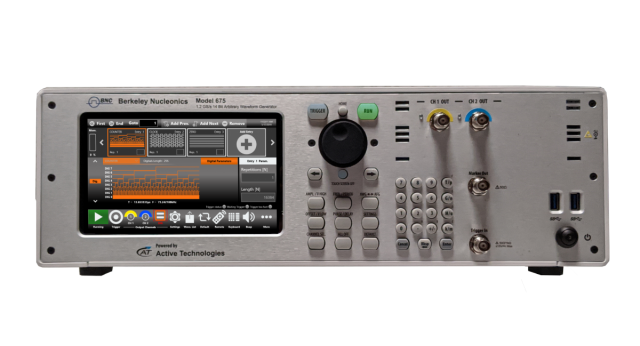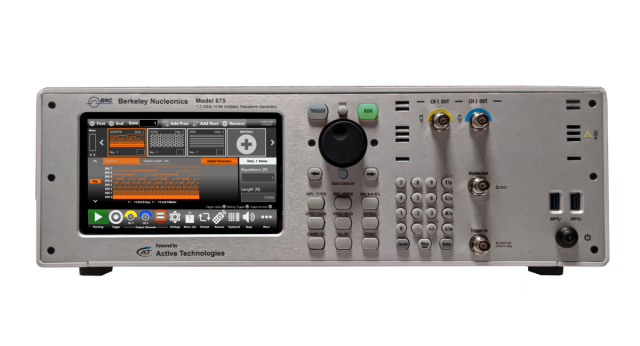The Model 675 offers premium signal integrity with an easy to use and robust touch-screen display interface. The output voltage can be adjusted in amplified mode up to 24 Volts. The Disruptive and innovative architecture provides unmatched performance, versatile functionality, outstanding usability, and upgradability during the life of the instrument.
Model 675 DEVICE CONFIGURATOR
| Number of Channels: | Two-Channel Four-Channel Eight-Channel |
 |
| Memory Option: | 2 Million Points Memory [standard] 64 Million Points Memory [option -64M] 128 Million Points Memory [option -128M] 1 Billion Points Memory [option -1G] |
|
| Output Options and Accessories: |
High Voltage Output (12 Vpp into 50 Ω) [option -HV2 ] Mini SAS HD to 16 SMA cable (8 LVDS output) [AT-LVDS-MSA8] |
|
|
Model 675-2C-2M
300 MHz, 2 Million Points Memory, 1.2 GSa/s AFG
|
||
Overview
Features |
Applications |
|
|
| Mode of Operation | Arbitrary Function Generator (AFG) Arbitrary Waveform Generator (AWG) TrueARB |
| Number of Outputs | 2, 4 or 8 Channels |
| Frequency Range | 1 µHz to 300 MHz sine wave (AFG Mode) |
| Waveforms | Sine, Square, Ramp, Pulse, Gaussian, Lorentz, Exp Rise, Exp Decay, Haversine, Sinc, Noise, Arbitrary, DC, Double Pulse |
| Run Mode | Continuous, Modulation, Sweep, and Burst |
| Amplitude | 0 to 6Vpp [optional 12Vpp] |
| Offset | -6V to +6V |
| Resolution | 100 µV |
| Initial Delay | 0 to 14 seconds |
| Phase | 0 to 360° |
| Polarity | Positive and Negative |
| Output Impedance | 50 Ω or 5 Ω |
| Sample Rate *** NEW!!! | 1.2 GS/s Fixed Clock 1.2 GS/s Variable Clock, |
| Minimum Pulse Width | 2.5 ns |
| Marker Outputs | 1 |
| Modulating Frequency | 500 µHz - 48 MHz Internal 8MHz Max External |
| Rise and Fall Time (20% to 80%) | < 700 ps @ 1 Vpp < 900 ps @ 5 Vpp |
| Digital Channel (optional) | 8 Bits (TrueARB Mode) |
| Waveform Memory | Up to 128 Million Points (TrueARB Mode) |
| Bandwidth | 318 MHz (TrueARB Mode) |
| Waveform Memory | Up to 128 Million Points (TrueARB Mode) |
| Mechanical (W x H x D) Weight |
17.7 x 6.3 x 13.4 inch [450 x 160 x 340 mm] 4.4 lbs [9.7 kg] |
| Power Source | 100 to 240 VAC / 45-66 Hz 120 Watts (max) |
| Emission and Immunity | CISPR 11, Class A, EN61000-3-2:2006, EN 61000-3-3:1995 EN 61326-1:2006, IEC 61000-4-2:2001, IEC 61000-4-3:2002, IEC 61000-4-4:2004, IEC 61000-4-5:2001, IEC 61000-4-6:2003, IEC 61000-4-11:2004 |
| Operating Environment | Temperature: +32 ºF to +122 ºF [0 ºC to +50 ºC] Humidity: 8% to 90% RH Altitude: 10,000 ft [3048 m] |
| Shipping Dimensions | 24x19x13" |
| Shipping Weight | 27 lbs |
Serial Data Pattern Generator
The Model 675 is the ideal serial data pattern generator for almost every experiment. With up to 8 channels of a data stream, built-in PRBS sequences, modulation capabilities, transition shaping, and the flexibility of a powerful analog front-end, the Model 675 Serial Data Pattern Generator is the perfect tool for even the most challenging applications.
Automotive
Today’s cars include many highly sophisticated Electronic Control Unit (ECU) with sensitive electronic components. The Model 675 combines 1.2 GS/s with a 14-bit 16-bit vertical resolution, making it an ideal tool for successfully addressing the new testing challenges in the automotive industry.
- CAN bus, CAN-FD, LIN, Flexray, SAE J2716 SENT Protocol Emulation
- EMI debugging, troubleshooting, and testing
- Electrical standards emulation up to 24V
- Power MOSFET circuitry in automotive electronics optimization
IoT and Industry 4.0
Arbitrary waveform and function generators will help define new industrial practices for testing the compliance of smart devices. These machines can modulate RF I/Q, enabling simulated testing environments, and are capable of generating noise to test against wireless devices, allowing for emulations close to or matching compliance test standards required for industry 4.0 applications.
University and Research Institute
Research centers and Universities are key users of the Model 675 Arbitrary Waveform series. Complex waveform and/or sophisticated pulse emulation based on variable edges or multilevel can be perfectly created. The combination of fast edge generation, excellent dynamic range, and an easy-to-use user interface combine perfectly for scientists and engineers working on large experiments such as accelerators, tokamak, or synchrotrons to emulate signals without creating specifics test boards.
- Emulation of Detectors
- Emulation of Noise adding Signal Sources
- Generation or Playback of Real-world Signals
- Emulation of long PRBS (PseudoRandom Binary Sequence)
- Modulating and Driving Laser Diodes
Aerospace and Defense
Electronic Warfare signals driven by Radar or Sonar systems match perfectly with these generators. Large BW Riders can be used on digital modulation systems for radio applications or other I/Q signal modulation. Pulses may be easily generated for applications such as Pulse Electron Beams, X-ray sources, Flash X-ray Radiography, Lighting Pulse simulators, and High Power Microwave modulators.
- Frequency Response, Intermodulation Distortion, and Noise-Figure measurements
- Phase-Locked Loop (PLL) pull-in and Hold Range characterization
- Radar Base-band Signals Emulation
Semiconductor Tests
Emulation of complex signals generated with the inclusion of noise or distortions is an excellent way to provide the Compliance Components Test to help semiconductor engineers. The fast edges and pulse generation can be used to provide characterization in fast power devices.
- Clock and Sensor Signals Generation
- MOSFET gate drive Amplitude Signal Emulation
- Power up sequences of IC using the Low Impedance feature (5 Ω output impedance)
Downloadable resources such as datasheets, firmware, software, drivers and products manuals. Alternatively, you can browse resources directly by visiting our downloads page.
• Product Datasheets
• Product Firmware
• Product Software and Drivers
• Product Manuals
Media
Price List
Price lists are available to our registered users. To view pricing for this and other products, please log in or create a free account.







